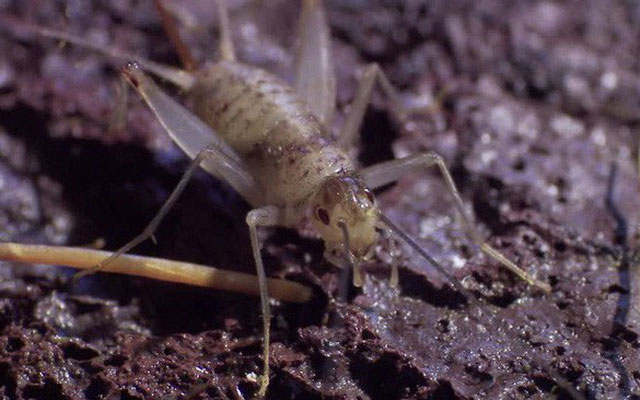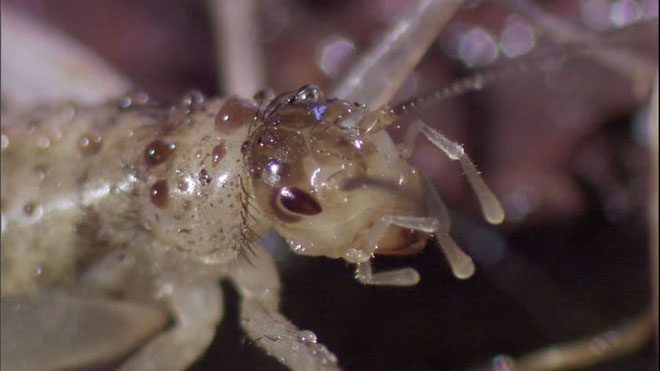Lava crickets: Legendary animals appear only after volcanic eruptions, the grass has just disappeared
No one knows normally, where this mysterious cricket resides, how it lives. Only when the volcanic eruption had just ended for a couple of months, when the lava began to cool, they suddenly appeared.
For a long time, people in Hawaii, a volcanic island in the North Pacific, have known the existence of this mysteriously hidden lava crickets. After a volcanic eruption, there was no revival of life-recovery on an empty platform, they were present. But when the first sprout of grass has just emerged, it all suddenly disappears, leaving no trace.
The pioneer moved into the world, the coal ash just cooled
In 2018 after nearly 100 years of peace, Hawaii's Kilauea volcano suddenly exploded, shooting columns of ash and smoke 9km high, overflowing with lava swallowing fields, houses, roads, even a boat dock.
It took several months, the red hot lava flow gradually cooled down, exposing the deserted, black, soulless landscape. But with lava crickets - the tiny, lovely "resident" of Hawaii, the deadly world is the most ideal home.


Lava crickets.
They hurriedly moved in, becoming the earliest multicellular life to have the middle of the ruins. "Where the volcanic lava has just cooled, there are lava crickets," - Marlene Zuk, entomologist at the University of Minnesota in St. Louis. Paul, USA affirmed.
The scientific name of lava crickets is Caconemobius fori . They are one of 15 subspecies of Caconemobius, cricket houses scattered along the Pacific coast and in the Hawaiian Islands.
While most Caconemobius crickets can be found under rocks on beaches, Caconemobius fori suddenly appears only after a brief volcanic eruption.
And then they suddenly disappear, leaving no trace to detect.
Eat decaying plants and drink sponges
It was not until 1978, the crickets that lived in these cool new lava fields were confirmed and named by scientists.
In the deserted land, they patiently chew on the dried plant material that was swept from the outside by the wind, stuck in lava slots and drank sponges. According to the analysis, the sponge contains a protein compound called albumen (egg white). They provide important nutrients for lava crickets to grow well.

They eat plant corpses and sponges.
There are two great advantages for lava crickets in a cool medium lava field, which is a wide range of survival and no food competitors. In the daytime, they lurk in black lava slots, quietly descending into the night to search for food.
After last year's Kilauea volcanic eruption, Zuk immediately realized the unique opportunity for a thorough study of this mysterious cricket has arrived. She quickly set out for Hawaii, because "when the grass grows, it's too late."
Originally, the insect's strength was its wings. Thanks to wings, they are easy to move and create a sound to call your partner. Strangely, lava crickets, crickets that live in the harshest environment, do not have wings. Of course they can't fly or speak to each other.
Mating . suicide
Although until now, scientists still do not know how lava crickets attract the enemy, but have observed the most macabre mating behavior. While doing . that, lava crickets will bite the male's legs, leisurely suck blood (actually hemolin fluid, because the insects have not developed so-called blood).
After a relationship, male crickets can lose 3-8% of their body weight. The weather in the new cold lava area is extremely dry and hot, so having to exchange an amount of this valuable fluid is indeed a big bet.



While doing . that, lava crickets will bite the male's legs, leisurely sucking blood.
"Normally when talking about cocoons like in the natural world, we often see children as the ones who have the right to choose," said Jeremy Marshall, an insect researcher at Kansas State University in Manhattan. "But in the case of mating activities that harm the male, the order of choice will be reversed."
But Lava's house follows this "common sense" or we still cannot know. Currently, scientists still do not have any confirmation. They have not even found chemical signals between male and female lava crickets. It is not yet known whether they gather together in groups or live separately.
However, during this "military out" , Marlene Zuk was determined to flip open all mysteries. She also plans to catch some pregnant Lava crickets back in the lab, so that she can learn more thoroughly. So we can count on the efforts of Zuk and other support researchers.
- Overwhelmed with volcanic eruptions
- Effect of volcanic eruption phenomenon
- What happens when volcanoes erupt under a glacier?
- Stunning images of volcanic eruptions when viewed from above
- Find the key to predict the volcanic eruption
- A lot of things about ancient Chinese cricket cages: Great artifacts of mankind
- The most brilliant volcanic eruption in the solar system
- Volcanic eruptions create new islands
- 11 most terrifying eruptions in history
- Breathtaking spectacle
- Indonesia was shaken by volcanic eruptions and earthquakes
- Not magma, this is the most dangerous thing from volcanoes
 Why do potatoes have eyes?
Why do potatoes have eyes? 'Tragedy' the world's largest carnivorous life: Death becomes ... public toilet
'Tragedy' the world's largest carnivorous life: Death becomes ... public toilet Tomatoes were once considered 'poisonous' for 200 years
Tomatoes were once considered 'poisonous' for 200 years Detecting microscopic parasites on human face
Detecting microscopic parasites on human face